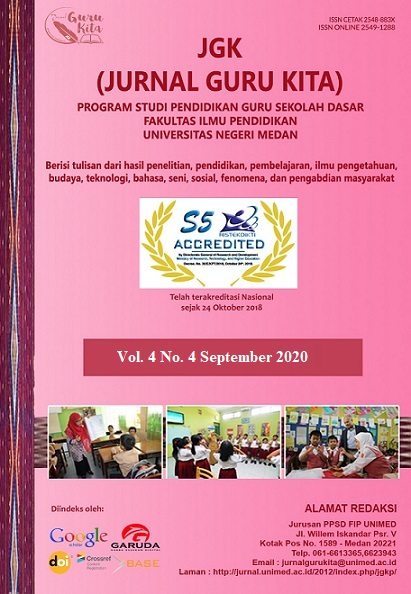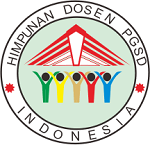PENERAPAN PEMBELAJARAN NUMBERED HEADS TOGETHER (NHT) UNTUK MENINGKATKAN HASIL BELAJAR SISWA KELAS X PADA MATERI IKATAN KIMIA DI SMK NEGERI 1 GANDAPURA
DOI:
https://doi.org/10.24114/jgk.v6i3.36551Keywords:
Model Pembelajaran Numbered Heads Together (NHT), Hasil Belajar Siswa, Ikatan KimiaAbstract
Abstract: Application of Numbered Heads Together (Nht) Learning to Improve Class X Students' Learning Outcomes on Chemical Bonds at Smk Negeri 1 Gandapura. This research was conducted by giving a pre-test to students to determine students' initial abilities before learning, then subjected to the Numbered Heads Together (NHT) learning model treatment on Chemical Bonding material for 6 hours of lessons with 2 meetings. After finishing the lesson, a post-test was given to determine the increase in student learning outcomes. The final test of the first cycle of action was obtained by students who did not achieve the minimum completeness criteria (KKM) totaling 8 people (28.57%) while students who achieved the completeness criteria scores were 20 people (71.43%), the results of the observation were that there were research activities in the action Cycle I achieved a score of 90% and the results of observing student activities reached 83.75%. While the final test of the second cycle of action obtained students who did not achieve the minimum completeness criteria (KKM) totaled 3 people (10.72%) while students who achieved the completeness criteria scores were 25 people (89.28%), the results of observations on the activities of researchers in The second cycle of action obtained a score of 94.2% and the results of observing student activities reached 93.75%. Thus, it can be concluded that the Numbered Heads Together (NHT) learning model can improve student learning outcomes on Chemical Bonding material in class X SMK Negeri 1 Gandapura. Keywords: Numbered Heads Together (NHT) Learning Model, Student Learning Outcomes, Chemical Bonds Abstrak: Penerapan Pembelajaran Numbered Heads Together (Nht) Untuk Meningkatkan Hasil Belajar Siswa Kelas X Pada Materi Ikatan Kimia di Smk Negeri 1 Gandapura. Penelitian ini dilakukan dengan cara memberikan pre-test pada siswa untuk mengetahui kemampuan awal siswa sebelum pembelajaran, selanjutnya dikenakan perlakuan model pembelajaran Numbered Heads Together (NHT) pada materi Ikatan Kimia selama 6 jam pelajaran dengan 2 kali pertemuan. Setelah selesai pembelajaran, diberikan post-test untuk mengetahui peningkatan hasil belajar siswa. Tes akhir tindakan siklus I diperoleh siswa yang tidak mencapai nilai kriteria ketuntasan minimal (KKM) berjumlah 8 orang (28,57%) sedangkan siswa yang mencapai nilai kriteria ketuntasan berjumlah 20 orang (71,43%), hasil observasi terdapat aktivitas peneliti pada tindakan siklus I mencapai skor 90% dan hasil observasi aktivitas siswa mencapai 83,75%. Sedangkan tes akhir tindakan siklus II diperoleh siswa yang tidak mencapai nilai kriteria ketuntasan minimal (KKM) berjumlah 3 orang (10,72%) sedangkan siswa yang mencapai nilai kriteria ketuntasan berjumlah 25 orang (89,28%), hasil observasi terhadap aktivitas peneliti pada tindakan siklus II memperoleh skor 94,2% dan hasil observasi aktivitas siswa mencapai 93,75%. Dengan demikian dapat disimpulkan bahwa model pembelajaran Numbered Heads Together (NHT) dapat meningkatkan hasil belajar siswa pada materi Ikatan Kimia di kelas X SMK Negeri 1 Gandapura Kata Kunci: Model Pembelajaran Numbered Heads Together (NHT), Hasil Belajar Siswa, Ikatan KimiaReferences
Arikunto, Suharsimi. (2007). Penelitian Tindakan Kelas. Jakarta: Bumi Aksara
Chafidzah. (2010). Buku Ajar Kimia Untuk SMK Semester 1 Kelas X. Solo: Sindunata.
Djamarah, Aswan. (2006). Strategi Belajar Mengajar. Jakarta: Rineka Cipta.
Hamzah. B. Uno. (2009). Model Pembelajaran Menciptakan Proses Belajar Mengajar Yang Kreatif dan Efektif. Jakarta : Bumi Aksara.
Ibrahim, dkk. (2000). Pembelajaran Kooperatif. Surabaya: UNESA Press
Moleong, J.Lexy. (2007). Metodologi Penelitian Kualitatif. Bandung: Remaja Rosdakarya.
Moleong, J.Lexy. (2009). Metodologi Penelitian Kualitatif. Bandung: Remaja Rosdakarya.
Rusman. (2010). Model-model Pembelajaran. Jakarta : Rajawali Pers.
Rustam dan Mundilarto. (2004). Penelitian Tindakan Kelas. Depdikbud
Saragih, Sahat. (2006). Jurnal Pendidikan dan Kebudayaan.
Sanjaya, Wina. (2008). Strategi Pembelajaran Berorientasi Standar Proses Pendidikan. Bandung: Alfabeta
Slameto. (2003). Belajar dan Faktor-faktor yang Mempengaruhinya. Jakarta: Rineka Cipta
Purwanto. (2010). Evaluasi Hasil Belajar. Yogyakarta: Pustaka Pelajar.
Poskur,dkk. (2003). Proses Belajar Mengajar. Bandung: PT. Remaja Rosda Karya
Wirodikromo, S. (2006). Kimia Untuk SMK Kelas X. Jakarta: Erlangga.
Zainurie. (2007). Pembelajaran Kooperatif. http://ainurie.Files.Wordpress.com.
Downloads
Published
How to Cite
Issue
Section
License
Authors published with the JGK (Jurnal Guru Kita) agree to the following terms:
- Authors retain copyright and grant the journal the right of first publication with the work simultaneously licensed under a Creative Commons Attribution License (CC BY-SA 4.0) that allows others to share the work with an acknowledgment of the work's authorship and initial publication in this journal.
- Authors are able to enter into separate, additional contractual arrangements for the non-exclusive distribution of the journal's published version of the work (e.g., post it to an institutional repository or publish it in a book), with an acknowledgment of its initial publication in this journal.
- Authors are permitted and encouraged to post their work online (e.g., in institutional repositories or on their website) prior to and during the submission process, as it can lead to productive exchanges, as well as earlier and greater citation of published work. (See The Effect of Open Access)




























